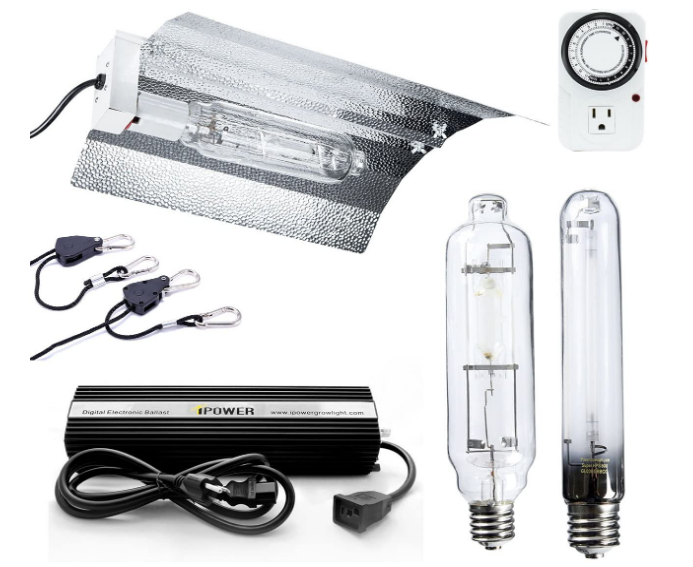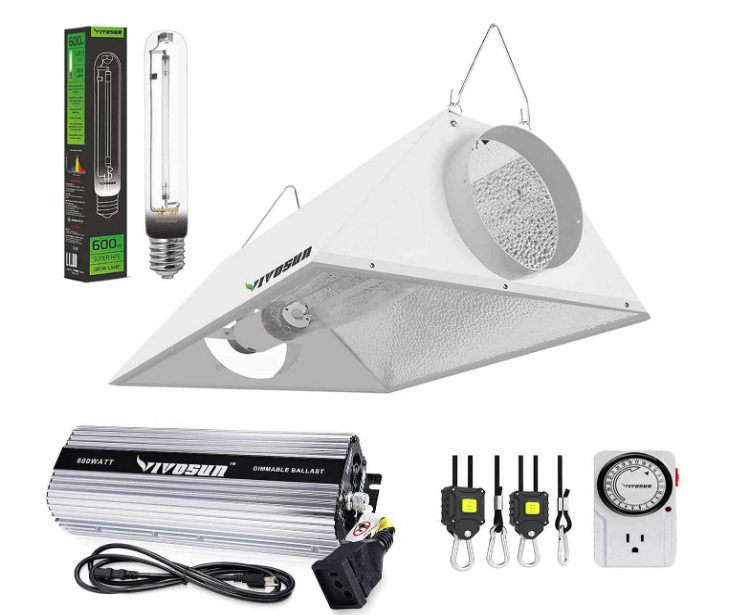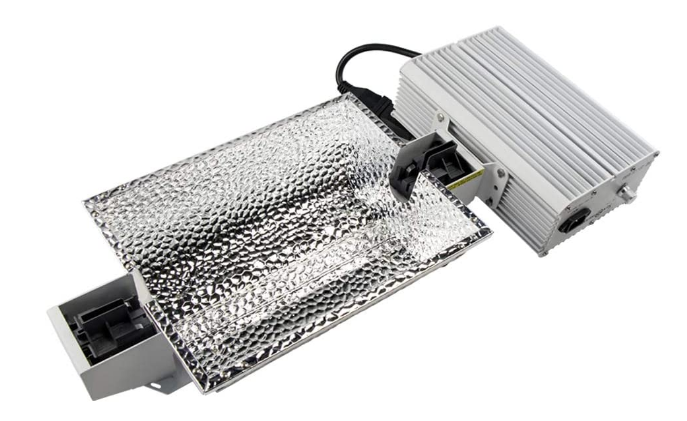All You Need to Know about HPS Grow Lights
HPS grow lights, short for High-Pressure Sodium grow lights, are indispensable tools in the indoor gardening industry. These lights provide artificial illumination necessary for plants to thrive when natural sunlight is limited or unavailable. With their specific light spectrum optimized for each stage of plant growth, HPS grow lights play a pivotal role in ensuring optimal yields and healthy plant development.
This post will further dig into HPS lights and discuss what outstanding advantages they bring to you. More importantly, you can find a detailed review of the best HPS grow lights to lead you to wise choices.
Table of Contents
Comprehensive Overview of HPS Grow Light
As a branch of HID (high-intensity discharge) light, HPS, or High-Pressure Sodium, grow lights are a type of artificial lighting that’s used to grow plants. These lights employ high-pressure sodium gas inside a bulb to produce light that is beneficial for plant growth.
How Does It Work
In order to benefit your plants, several components of HPS grow lights are needed.
HPS Bulb
Firstly, there is the HPS bulb, which contains a blend of noble gases, mercury, and sodium that are stored in the arc tube. When an electrical current passes through the bulb, the ballast ignites the gases, causing the sodium to vaporize and emit light.
The emitted light from HPS bulbs falls primarily within the red and orange spectrum, which is particularly effective for promoting flowering and fruiting in plants. This growth light spectrum is ideal for stimulating photosynthesis and facilitating essential processes like chlorophyll production and flowering hormone synthesis.
Reflector
Another crucial component is the reflector, which surrounds the bulb and directs the light downward, minimizing light loss and maximizing the coverage area. The light is distributed evenly with reflectors, ensuring that plants receive sufficient illumination for optimal growth.
Cooling System
Heat dissipation is a critical consideration in HPS grow lights due to the significant heat generated during operation. To manage heat, cooling systems like fans or exhaust systems are employed to maintain the ideal temperature range and prevent damage to the plants or the lighting system.
Overall, HPS grow lights work by utilizing high-pressure sodium gas inside a bulb, generating light in the red and orange spectrum, plus some blue light. Combined with the appropriate ballast, reflector, and cooling or ventilation system, HPS grow lights create an efficient and effective lighting solution for indoor gardening.
Two Types of HPS Lights
When choosing HPS lights, there are two variations, single-ended HPS grow lights and double-ended HPS grow lights. While they operate on the same fundamental principles, there are notable differences between the two.
Single-ended HPS Grow Lights: Single-Ended HPS grow lights feature a traditional Edison style in that the electrical connection is made on one end of the bulb. The bulb itself contains a single arc tube that houses the gases and materials necessary for producing light.
Double-Ended HPS Grow Lights: Double-Ended HPS grow lights, as the name suggests, have electrical connections on both ends of the bulb. These lights use a unique design with two arc tubes instead of one.
Key Differences:
- Light Output: Double-ended HPS grow lights generally produce higher light output compared to single-ended ones, resulting in increased intensity and improved penetration of light throughout the plant canopy.
- Efficiency: Double-ended HPS grow lights tend to have a higher conversion of electrical energy into usable light for plants.
- Lifespan: Thanks to factors such as improved electrode design and reduced arc tube degradation, double-ended HPS bulbs typically have a longer lifespan than single-ended bulbs.
Benefits of HPS Grow Lights
Compared with other grow lights in the market, HPS grow lights offer several key benefits that make them a popular choice among growers.
High Light Output and Intensity: HPS grow lights are well known for their exceptional light output and intensity. For example, a 1000w HPS light can output approximately 110,000 to 140,000 lumens, which is way more than that of a LED grow light. The intense light produced by HPS bulbs ensures that plants receive ample energy for photosynthesis, leading to robust foliage, sturdy stems, and abundant yields.
Spectral Output for Plant Growth: HPS grow lights emit light in the red, orange, and blue spectrum, which corresponds to wavelengths that are highly beneficial for flowering and vegging stages. The spectral output of HPS lights is well-suited for optimizing the growth and productivity of flowering plants and fruit-bearing crops, such as roses, tomatoes, and peppers.
Cost-Effective Option: HPS grow lights are generally more affordable compared to certain other lighting technologies like LED grow lights. They provide a budget-wise solution for indoor gardeners, especially those who are starting out or have budget constraints.
Top HPS Grow Lights You Don’t Want to Miss
With massive HPS lights options, which ones are worth recommending? No need to be overwhelmed, we’ve picked the best HPS grow lights for you.
iPower 600 Watt HPS MH Digital Dimmable Grow Light

The iPower 600 Watt HPS MH Digital Dimmable Grow Light is a versatile lighting system that works with both High-Pressure Sodium (HPS) and Metal Halide (MH) bulbs, allowing growers to use HPS bulbs for flowering and MH bulbs for vegetative growth and therefore providing the right spectrum for each stage. Additionally, it shares other advantages as followed.
Dimmability: It offers large versatility that permits you to adjust the light output according to the specific needs of your plants during different growth stages.
Digital Ballast: iPower HPS light features a digital ballast that is given high credits in terms of the ability to reduce power fluctuations and provide a consistent light output, contributing to better plant growth and energy efficiency.
VIVOSUN Hydroponic 600 Watt HPS Grow Light

VIVOSUN Hydroponic HPS Grow Light is yet another excellent HPS light in the market. The reflector that’s made up of over 90% high reflectivity aluminum ensures the soonest flourish of your plants.
24-Hour Timer: The 24-hour plug-in mechanical timer switch automates your lighting requirements and provides convenience while promoting consistent and productive plant growth. It offers 15-minute On/Off intervals and 24-hour settings, allowing you to easily schedule your lighting needs.
Improved Cooling System: The internal fan cooling system contributes to 25% less heat generation and extends the product life span by 15%. It also includes various protection features such as overheating protection, end-of-bulb-life protection, short circuit protection, and ignition failure protection.
SunStream 1000 Watt DE Double-Ended HID Grow Light

You can easily tell from the name that, unlike the former two HPS lights, this best HPS grow light is a double-ended one. With its double-ended design, it offers several advantages over traditional single-ended HID (High-Intensity Discharge) grow lights.
Double-Ended HPS Grow Light: The two-ended connection provides more stable and reliable electrical connectivity, resulting in higher light output and longer bulb life.
1000w High-Quality HPS Grow Light: The 1000W HID grow light kit is crafted using premium hardware components and undergoes a rigorous quality assurance process, ensuring exceptional quality.
Conclusion
HPS grow lights can greatly boost your indoor growing if applied properly. Their efficient lamp efficacy and broad-spectrum make them effective for promoting healthy plant growth and robust yields. With their ability to support both vegetative and flowering stages, HPS lights offer versatility for various growth phases.
FAQs about HPS Grow Lights
- Is HPS grow light better than LED?
When comparing these two grow lights, LED lights are more energy-efficient, offer customizable spectrums, produce less heat, and have a longer lifespan, while HPS lights have a lower initial cost and remain reliable for larger spaces.
- Are HPS lights good for growing?
Yes, HPS lights are good for growing plants by providing a beneficial light spectrum for robust growth, especially during flowering and fruiting stages. However, the heat output and energy efficiency are two main drawbacks of HPS lights that you should take into consideration.
- How much does it cost to run a 1000-watt HPS grow light?
To estimate the cost of running a 1000-watt HPS grow light, let's assume it runs for 18 hours per day. If the electricity rate is $0.12 per kilowatt-hour (kWh), the monthly cost would be approximately $64.80. However, please note that electricity rates vary, so it's best to check with your utility provider for accurate cost calculations based on your specific location and energy rates.
- How high should HPS light be for veg?
The optimal height for HPS lights during the vegetative stage of plant growth typically ranges from 18 to 24 inches (45 to 60 centimeters) above the canopy. Anything below or above the range may not lead to optimal effect.




![Best-HPS-Grow-Lights-for-Indoor-Gardening-[2023-Review]](https://www.spider-farmer.com/wp-content/uploads/2023/05/Best-HPS-Grow-Lights-for-Indoor-Gardening-2023-Review.jpg)

